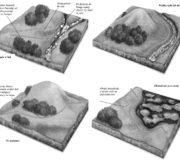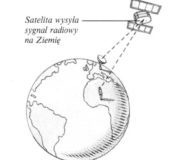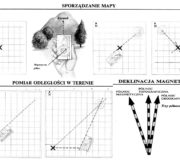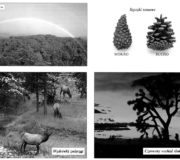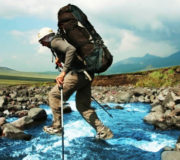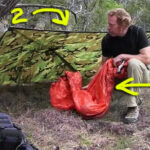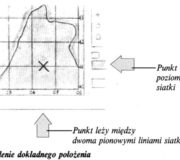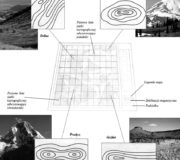Orientacja w terenie wymaga przede wszystkim umiejętności posługiwania się mapą i kompasem. Służą one do wytyczenia najkrótszej, a zarazem najbezpieczniejszej drogi w zróżnicowanym terenie. Na lądzie nie sposób tak precyzyjnie określić drogi, jak na morzu. Tam można wyznaczyć prosty kurs, gdyż tylko wiatr, pływy i zmiany linii brzegowej wprowadzają korekty. Szybkość poruszania się na lądzie zależy od bardzo wielu czynników – ukształtowania terenu, typu podłoża. ^ klimatu, aktualnej pogody. Orientacja w terenie wiąże się z koniecznością stałych zmian obranej drogi, omijania przeszkód, oraz pamiętania o tym, by zawsze wrócić na szlak.
Migracje zwierząt – Wiele ptaków wędrownych ma zakodowany zmysł orientacji, który pozwala im wracać co roku do tych samych miejsc lęgowych, nawet z drugiego końca ziemskiego globu.
ORIENTOWANIE MAPY
Przed wyruszeniem w drogę należy zorientować mapę, czyli posługując się kompasem ustawić ją tak, aby kierunki określone na niej pokrywały się z odpowiednimi kierunkami w terenie. Wówczas będziesz mógł wyznaczyć azymut, który wskaże kierunek celu Twojej podróży. Oprócz tego musisz zmierzyć odległość do punktu końcowego posługując się skalą kompasu lub podziałką mapy. Po obraniu azymutu i wyruszeniu w drogę sprawdzaj często mijane obiekty z zaznaczonymi na mapie.
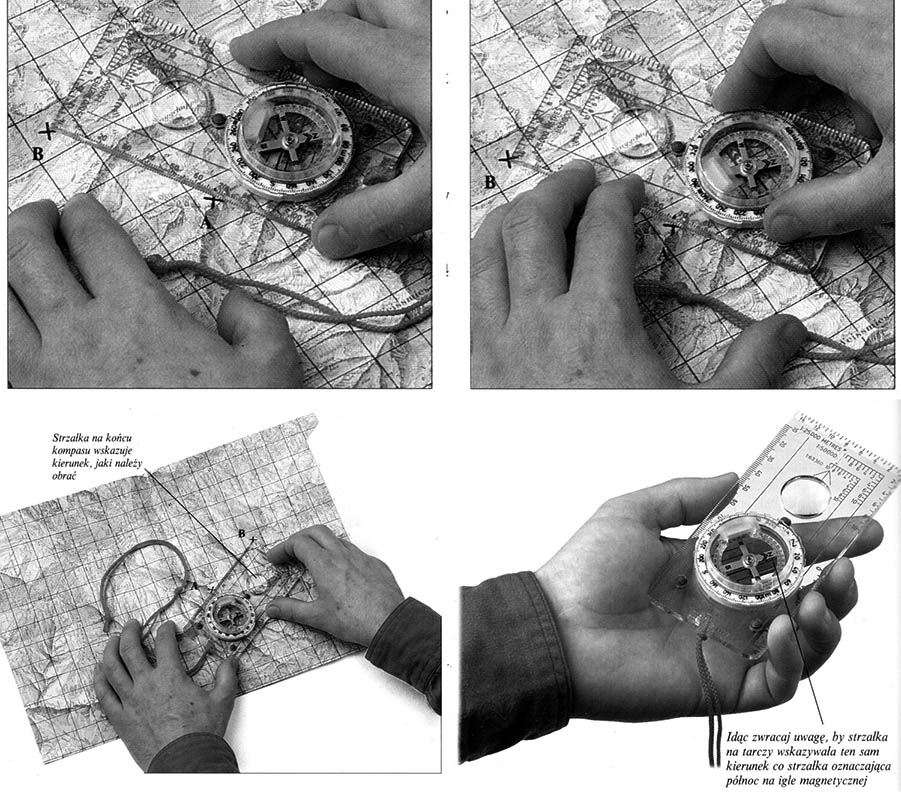 1 Aby wyznaczyć azymut, określający kierunek, w którym należy iść, by z punktu A osiągnąć punkt B, należy ułożyć kompas na mapie między A i B, strzałką skierowaną w stronę B. Trzeba odczytać odległość między obydwoma punktami ze skali na brzegu kompasu i porównać ją z podziałką mapy.
1 Aby wyznaczyć azymut, określający kierunek, w którym należy iść, by z punktu A osiągnąć punkt B, należy ułożyć kompas na mapie między A i B, strzałką skierowaną w stronę B. Trzeba odczytać odległość między obydwoma punktami ze skali na brzegu kompasu i porównać ją z podziałką mapy.
2 Nie ruszając kompasu trzeba obrócić tarczę w środku tak, by równolegle linie oznaczające oś północ-południe pokrywały się z liniami siatki topograficznej na mapie. Czerwona strzałka na tarczy, wskazująca północ, powinna pokazywać kierunek północny na mapie. W ten sposób ustawiamy na kompasie azymut, czyli kąt między kierunkiem z A do B a północą magnetyczną.
3 Obracamy mapą wraz z kompasem do momentu, gdy strzałka na tarczy znajdzie się w jednej linii z igłą magnetyczną i będzie pokazywała północ. Strzałka na końcu kompasu pokazuje kierunek, w jakim znajduje się punkt B w terenie.
4 Można teraz, trzymając kompas w dłoni, iść w kierunku wskazanym przez strzałkę. Należy tylko uważać, by strzałka na tarczy wskazywała ten sam kierunek co igła magnetyczna. Będziesz wówczas stale podążał zgodnie z obranym azymutem.
